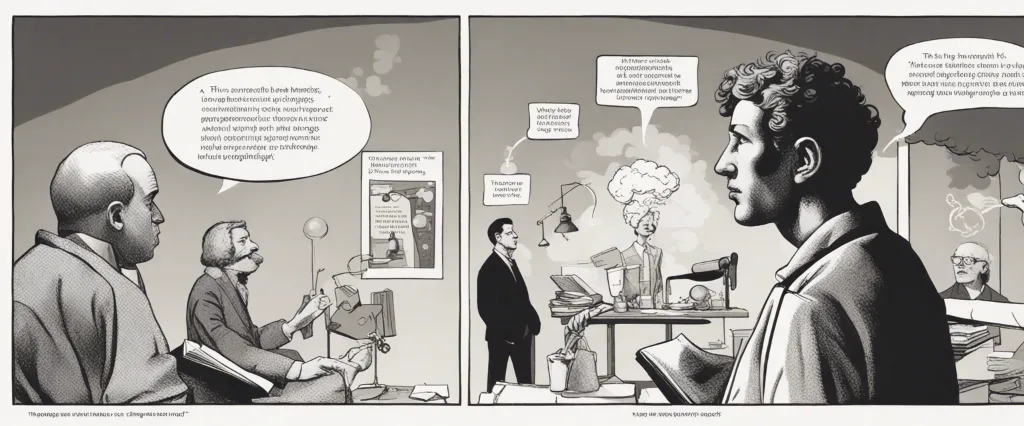In “Thoughts Without A Thinker,” Mark Epstein skillfully fuses the timeless wisdom of Buddhist philosophy with the practice of psychotherapy. In this groundbreaking work, he explores the transformative potential of integrating these two seemingly disparate disciplines. Epstein, a renowned psychiatrist and meditation teacher, draws from his personal experiences to shed light on the fundamental workings of the mind and offers a fresh perspective on resolving inner conflicts. By delving into the intricate interplay between Buddhism and psychotherapy, Epstein invites readers to embark on a journey of self-discovery and a deeper understanding of the human psyche.
Chapter 1: The Illusion of a Separate Self: Exploring the Concept of Ego and Its Impact
Chapter 1 of “Thoughts Without A Thinker” by Mark Epstein explores the concept of the ego and its impact on an individual’s sense of self. Epstein delves into the idea that the ego, or the separate self, is an illusion that humans create in order to navigate the complexities of life.
The chapter begins by discussing the origins of the concept of the ego, tracing it back to Sigmund Freud and his theories on the human psyche. Freud believed that the ego is the part of the mind that mediates between the impulses of the id and the demands of the superego, essentially serving as a filter for desires and societal expectations.
Epstein argues that while the ego can be beneficial in helping individuals function within society, it also creates an illusion of a separate self, disconnected from the rest of existence. He points out the suffering that arises when people identify too strongly with this egoic self and become trapped in the constant pursuit of personal desires and protections.
Through examples from his own psychotherapy practice, Epstein illustrates the ways in which people cling to their ego and struggle to let go of it. He highlights the attachment to various roles, identities, and possessions as manifestations of this illusionary self.
Epstein suggests that the goal should not be to eliminate the ego entirely but rather to develop a healthier relationship with it. By understanding that the ego is just a construct and by exploring the deeper layers of consciousness, individuals can begin to loosen their identification with the separate self and gain a more expansive sense of being.
In conclusion, Chapter 1 of “Thoughts Without A Thinker” introduces the concept of the ego, highlighting its illusionary nature and identifying its impact on human suffering. Epstein encourages readers to explore their own egos and seek a deeper understanding of their connection to the rest of existence.
Chapter 2: The Unconscious Mind: Delving into the Depths of the Psyche
Chapter 2 of Mark Epstein’s book “Thoughts Without A Thinker” delves into the concept of the unconscious mind as explored through the lens of psychoanalysis. The chapter begins by highlighting the profound impact of Sigmund Freud’s work on understanding the human psyche.
Epstein elucidates how the unconscious mind, as described by Freud, contains repressed thoughts, desires, and memories that exert a significant influence on our conscious experiences and behaviors. He explores the dynamic interplay between conscious and unconscious processes, bringing into focus the way hidden motivations shape our thoughts and actions.
Epstein introduces the concept of transference, a key element in psychoanalysis, where the patient’s unresolved emotions and attachments from the past are projected onto the therapist. Through transference, the patient can gain insight into their unconscious patterns and conflicts, leading to personal growth and healing.
The author emphasizes the vital role of empathy and curiosity on the part of the therapist in unraveling the unconscious manifestations. Epstein illustrates this with a case study, demonstrating how a therapist’s attunement to the patient’s unconscious signals can aid them in uncovering deeper psychological truths.
Epstein also explores the importance of dreams in accessing the unconscious. Dream analysis is seen as a crucial tool in psychoanalysis, as dreams often serve as a symbolic expression of unconscious desires, fears, and conflicts. By interpreting these symbols, individuals can gain a deeper understanding of the self.
Overall, Chapter 2 provides a comprehensive overview of the unconscious mind and its exploration through psychoanalysis. It highlights the significance of unconscious processes in shaping human behavior and how the therapeutic relationship can facilitate the uncovering and integration of these hidden aspects of the psyche.
Chapter 3: Embracing Impermanence: Understanding the Nature of Change and Letting Go
Chapter 3 of “Thoughts Without a Thinker” by Mark Epstein explores the concept of impermanence and its significance in understanding the nature of change and the art of letting go. The chapter delves into the Buddhist philosophy of impermanence and how it can be applied to psychological well-being.
Epstein begins by discussing the human tendency to resist change and seek permanence in our lives. He explains that this resistance often leads to suffering, as change is an inevitable part of existence. By acknowledging and accepting the impermanence of all things, including emotions and thoughts, we can find greater peace and clarity.
The author illustrates the power of impermanence through his clinical encounters with patients. He explains how the awareness of change facilitated his patients’ healing by helping them see beyond their current problems and understand that their pain would not last forever. Epstein emphasizes the importance of embracing the temporary nature of everything, including our own identities, relationships, and physical bodies.
Furthermore, the chapter explores various Buddhist teachings and practices that can help cultivate a deeper understanding of impermanence. Meditative techniques such as mindfulness and contemplation on death are highlighted as tools to develop an acceptance of change, ultimately leading to a more compassionate and flexible outlook on life.
Epstein concludes by noting that embracing impermanence is not about becoming detached or indifferent but rather about appreciating the beauty of each moment and fully engaging with life, knowing that it is constantly evolving. By letting go of our attachments to permanence, we can find freedom, resilience, and a deeper connection to ourselves and the world around us.
Chapter 4: The Power of Mindfulness: Cultivating Present-Moment Awareness

Chapter 4 of “Thoughts Without A Thinker” by Mark Epstein is titled “The Power of Mindfulness: Cultivating Present-Moment Awareness.” In this chapter, Epstein explores the concept of mindfulness as a powerful tool for self-awareness and personal growth.
Epstein begins by emphasizing the importance of being fully present in the present moment, rather than being preoccupied with thoughts about the past or future. He explains that this mindful awareness allows individuals to observe their emotions, thoughts, and bodily sensations without judgment or attachment.
The author introduces the practice of mindfulness meditation as a means to develop this present-moment awareness. He explains that through meditation, individuals can learn to observe their thoughts and emotions as they arise, and not get caught up in them. This practice helps to cultivate a sense of detachment and non-identification with the mind’s contents, enabling one to gain insight into the nature of their thoughts and emotions.
Epstein also explores the therapeutic benefits of mindfulness, particularly in the context of psychotherapy. He emphasizes how mindfulness can help individuals become more attuned to their internal experiences and emotions, allowing for a deeper understanding of their psychological patterns and conflicts. By cultivating this present-moment awareness, individuals can better navigate their relationships and make more conscious choices in their lives.
In summary, Chapter 4 of “Thoughts Without A Thinker” delves into the power of mindfulness in cultivating present-moment awareness. Epstein highlights mindfulness meditation as a practical tool to observe thoughts and emotions without judgment, leading to increased self-awareness and personal growth.
Chapter 5: Healing through Insight: Using Self-Reflection to Uncover Hidden Patterns
Chapter 5 of “Thoughts Without A Thinker” by Mark Epstein, titled “Healing through Insight: Using Self-Reflection to Uncover Hidden Patterns,” delves into the process of self-reflection and its power to reveal hidden patterns within our minds.
Epstein discusses how self-reflection is not just about introspection but also requires a certain level of objectivity. Through self-reflection, we gain the ability to observe our thoughts, feelings, and emotions without getting caught up in them. This detachment allows us to see the patterns and unconscious beliefs that drive our behavior.
The chapter explores the concept of insight, which Epstein defines as the transformative process of coming to understand the origins of one’s thoughts and emotions. He emphasizes that insight is not about blaming others or oneself, but rather about understanding the complex web of conditioning that shapes our thoughts and actions.
Epstein shares various examples from his clinical practice to illustrate the power of self-reflection and insight in healing psychological wounds. He presents cases where patients, through self-reflection, unearthed deep-seated beliefs, traumas, and unresolved conflicts that were causing their suffering. By gaining insight into these hidden patterns, individuals were able to break free from unconscious drives and find new ways of relating to themselves and others.
The chapter also explores how compassion plays a crucial role in the process of self-reflection. Epstein emphasizes that self-compassion allows us to face our inner pain and vulnerability with care and kindness, creating an environment for healing to take place.
In conclusion, Chapter 5 of “Thoughts Without A Thinker” highlights the significance of self-reflection in uncovering hidden patterns and achieving personal growth. Through the lens of insight, individuals gain a deeper understanding of themselves, compassionately investigate their inner selves, and ultimately find healing and transformation.
Chapter 6: The Dance of Attachment and Detachment: Balancing Connection and Freedom
Chapter 6 of “Thoughts Without A Thinker” by Mark Epstein explores the complex interplay between attachment and detachment, emphasizing the importance of balancing connection and freedom in relationships. Epstein delves into the concept of the dance between attachment and detachment, highlighting the Buddhist teachings of dependent origination.
The chapter begins by discussing the inherent human need for attachment, explaining that our earliest experiences with caregivers shape our ability to connect with others. Epstein explores how the attachment we form as children influences our adult relationships and the ways in which we seek love and connection. However, he warns of the dangers of becoming overly attached, which can lead to a loss of freedom and a dependency that stifles individual growth.
To counterbalance attachment, the concept of detachment is introduced. Detachment allows for a sense of freedom and autonomy within relationships, enabling individuals to maintain their own identities and desires. Epstein emphasizes that detachment is not about distance or isolation; rather, it is the ability to remain connected while also establishing healthy boundaries and maintaining independence.
Through anecdotes and case studies from his clinical practice, Epstein illustrates the challenges individuals face in finding the right balance between attachment and detachment. He suggests that understanding the dance between these two elements of relationships is crucial for personal growth and emotional well-being.
Ultimately, the chapter concludes by asserting that the dance of attachment and detachment is a lifelong journey. Finding equilibrium between the desire for connection and the need for freedom is an ongoing practice that requires self-reflection, self-compassion, and a deep understanding of one’s own needs and boundaries.
Chapter 7: The Path of Self-Inquiry: Questioning the Nature of Reality and Identity
Chapter 7 of Mark Epstein’s book “Thoughts Without A Thinker” focuses on the path of self-inquiry and the process of questioning the nature of reality and identity. Epstein explores the teachings from various traditions, including Buddhism and psychoanalysis, to help readers understand the importance of questioning our beliefs and assumptions.
Epstein begins the chapter by delving into the concept of anatta, or non-self, which is essential to Buddhist teachings. Anatta teaches that there is no fixed, unchanging self or essence that defines us. By questioning our identity and seeing through the illusion of a permanent self, we can develop a deeper understanding of reality and reduce suffering.
He then applies the principles of self-inquiry to the therapeutic context, discussing how introspection and questioning can be used in psychoanalysis to uncover the underlying motivations and patterns behind our thoughts, emotions, and behaviors. By examining our beliefs and assumptions, we can gain insight into the causes of our suffering and begin to transform them.
Epstein emphasizes the importance of paying attention to our subjective experience and observing the transient nature of thoughts and emotions. By questioning the reality and solidity of our thoughts, we can cultivate a sense of spaciousness and freedom in our minds.
Moreover, he explores the significance of questioning our cultural and societal conditioning, which often shapes our sense of self and reality. By becoming aware of these influences and investigating them, we can transcend limiting beliefs and explore alternative ways of being.
In summary, Chapter 7 of “Thoughts Without A Thinker” emphasizes the value of self-inquiry in questioning the nature of reality and identity. By exploring concepts from Buddhism and psychoanalysis, Epstein guides readers in understanding how introspection and investigation can lead to a deeper understanding of ourselves and the world around us.

Chapter 8: Transcending Dualities: Embracing Non-Duality and Finding Liberation in Awareness
Chapter 8 of Thoughts Without A Thinker by Mark Epstein, titled “Transcending Dualities: Embracing Non-Duality and Finding Liberation in Awareness”, delves into the concept of non-duality and its potential for personal liberation.
The chapter begins with a discussion on the human tendency to categorize experiences as good or bad, desirable or undesirable, and the subsequent suffering that arises from this dualistic thinking. Epstein introduces the idea that liberation lies in transcending these dualities and embracing a state of non-duality.
The author explores the concept of non-duality through various Eastern philosophies and spiritual traditions, such as Buddhism and Hinduism. He emphasizes the importance of understanding the interconnectedness and interdependence of all things, recognizing that the boundaries we perceive are merely conceptual constructs. Epstein explains that the root cause of suffering is attachment to these boundaries and the rigidity of dualistic thinking.
Epstein highlights the role of mindfulness and meditation in cultivating an awareness of non-duality. He suggests that by observing our thoughts, emotions, and sensations without judgment or attachment, we can gradually transcend the limitations of dualistic thinking and experience a sense of liberation. This practice allows individuals to become more attuned to the present moment and the interconnected nature of existence, leading to a more compassionate and accepting perspective.
The chapter concludes with a reminder that non-duality is not an intellectual concept to be understood solely through reading or contemplation, but an experiential journey that requires ongoing practice and dedication. Epstein encourages readers to explore non-duality in their own lives and discover the freedom and liberation that can be found by embracing this profound perspective.
After Reading
In “Thoughts Without A Thinker,” Mark Epstein explores the relationship between Buddhism and psychotherapy, offering a unique perspective on the merging of these two fields. The book delves into the idea that our thoughts and emotions are not fixed entities but rather passing mental phenomena, ultimately challenging the notion of a permanent self. Epstein skillfully weaves together theories, case studies, and personal anecdotes to illustrate the transformative potential of combining Buddhist teachings with Western psychology. By encouraging readers to embrace their imperfections and surrender to the ever-changing nature of existence, Epstein provides an insightful and thought-provoking guide to understanding the human mind. “Thoughts Without A Thinker” serves as a valuable resource for anyone seeking to navigate their inner world and cultivate a sense of peace and fulfillment.
1. The Power of Now” by Eckhart Tolle: Similar to “Thoughts Without A Thinker,” this book explores the concept of mindfulness and how it can bring peace and presence into our lives. Tolle’s teachings guide readers towards living in the present moment and overcoming the grip of the ego.
2. “The Untethered Soul” by Michael A. Singer: This book delves into the nature of consciousness and offers practical insights on how to break free from limiting beliefs and fears. Just like Epstein’s work, Singer’s book emphasizes the importance of self-awareness and the discovery of our true selves.
3. “Wherever You Go, There You Are” by Jon Kabat-Zinn: In this book, renowned mindfulness expert Jon Kabat-Zinn introduces readers to the practice of meditation and its potential to transform their lives. By focusing on the present moment and cultivating non-judgmental awareness, Kabat-Zinn guides readers towards a more peaceful and fulfilling existence.
4. The Brain That Changes Itself” by Norman Doidge: This book explores the remarkable capacity of the brain to rewire itself and adapt to new circumstances throughout our lives. Doidge challenges the traditional view of the brain as a fixed entity and highlights various case studies that support the idea of neuroplasticity.
5. Man’s Search for Meaning” by Viktor E. Frankl: Offering profound insights into the resilience of the human spirit, Frankl’s book recounts his experiences as a Holocaust survivor. As he reflects on the importance of finding meaning and purpose in life, Frankl provides valuable lessons on how to cope with adversity and find inner strength amidst the darkest of times.




